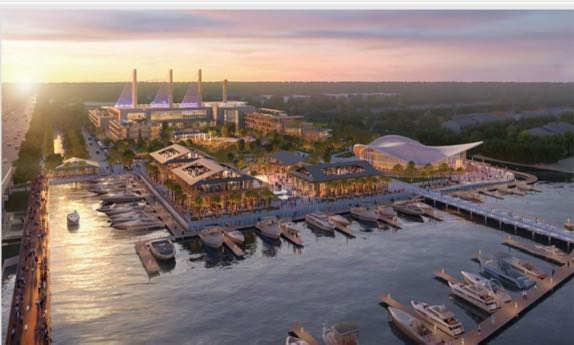
Ten months ago, Vero Beach officials unveiled Indiana-based Clearpath Services’ breathtakingly spectacular, $500 million proposal for the development of the Three Corners site at the west end of the 17th Street Bridge.
The development group’s vision, which included a Sydney Opera House-like Event Center on a manmade island in the lagoon and a kayak/paddleboard canal into the 17-acre property that currently contains the city’s abandoned “Big Blue” power plant, was as aspirational as it was ambitious.
The detailed, well-presented and wonderfully illustrated proposal was everything we could’ve hoped for in a plan to create a waterfront dining, retail, hospitality, social and recreational hub on the city’s mainland.
Somehow, though, the new scaled-back proposal Clearpath submitted last month – and that the city made public last week – is even better.
Yes, you read that correctly.
It’s better.
It’s better than last year’s proposal. And, based on an initial review last week, it’s more appealing than the plan submitted by The Blue at Vero Beach partnership, Clearpath’s lone competitor in the city’s second attempt to find a Three Corners developer.
There’s no manmade island. There’s no canal. But there’s still plenty of the “wow factor” that generated a buzz throughout the community and earned an overwhelming endorsement from the city’s Selection Committee last year – before the process was abandoned in May.
Clearpath’s new proposal, in fact, offers many of the same amenities and city-sought components identified in its original submission, including an Event Center which has been reduced in capacity to 350 to 400 seats and relocated to the mainland.
But what makes this plan superior to its predecessor is the way it has been tweaked in some areas and revised in others in response to concerns expressed and comments made during the previous process.
Simply put: Clearpath founder Randy Lloyd, who has vacationed in Vero Beach for years, wanted to impress us with their initial response to the city’s Request For Proposals by showing everyone what was possible.
This time, he and his team gave us a more-restrained – and, perhaps, more realistic – plan that, while still exciting, is more aligned with the Three Corners Master Plan and should be a better fit for our community.
“Our experience with the RFP process has granted us the opportunity to listen, learn and revise,” Clearpath’s proposal states. “Through much effort, we have further refined our vision for Three Corners that builds on the essence of our first submission.
“We continue to imagine a re-use of Big Blue that can firmly solidify Vero Beach’s image as a cultural and trend-setting community that embraces innovative ways to think about its role in creating a sense of place,” it continued. “The proposal presented is crafted to address the goals and objectives as stated by the community.
“We believe our reply provides a roadmap for turning our dream into reality for the citizens of Vero Beach.”
To deliver on that promise, Clearpath has assembled what it considers a “dream team” of partners, a group that includes The Ridge Group real-estate developers, HOK architects, Westminster Capital investors, Ennismore hotels, Bellingham Marine, Turner Construction and Kimley-Horn engineers.
The Clearpath proposal includes: two hotels with different price points; a Grand Promenade that runs the length of the property, reaching from Indian River Boulevard into the lagoon; larger Central Community Park with an amphitheater and stage; splash parks with pop-jet fountains; Waterfront Village and marina with 82 boat slips; fishing pier; kayak launch; skate park; children’s playground; and several restaurants, among them an on-the-water Tiki Boat Bar/Restaurant.
The new Clearpath plan would repurpose the front (west side) of the power plant to create a “multi-use public piazza suitable for farmer’s markets, festivals and other community events.”
A renovated Big Blue would also be equipped with sliding walls that could be opened during favorable weather and create a pass-through concourse breezeway.
Inside, there would be space for a boutique grocery store, a large market court available to local food, beverage and other retail vendors, and a balcony terrace from the food court that overlooks the public piazza.
Clearpath also has replaced the parking structure included in its initial plan with landscaped surface parking.
It’s no surprise, then, that the new proposal comes in at only half the price of the original plan.
But at $250 million, it still requires a greater investment than the $195 million proposal submitted by The Blue of Vero Beach partnership, which, now operated with a local address, appears to be a new version of the Pompano Beach-based SuDa group that headed its previous effort.
Both SuDa and Madison Marquette Real Estate Services, based in Washington, D.C., are still partners in the venture, but The Blue’s principal is now Edgar Jones, a Vero Beach resident and longtime developer.
For those who don’t remember: The City Council ignored the recommendation of its Selection Committee and chose SuDa to be its Three Corners developer in May, only to disqualify the group in June because one of its representatives violated the RFP’s terms by directly contacting council members.
Rather than abide by its RFP and moving forward with its second choice, Clearpath, the council turned the process into a clown show, embarrassing the city by voting for a do-over.
A new, more demanding RFP was issued in August. Two of the previous four developers decided not to bother, leaving only Clearpath and The Blue, both of which submitted proposals that appear to meet the city’s criteria.
The Blue’s proposal is, as you might expect, similar to the $144.3 million plan SuDa submitted last year, though much more developed. Indeed, the group’s initial offering last March lacked several of the RFP’s requirements.
City Councilman John Carroll would later say SuDa’s proposal was incomplete and should have been rejected from the outset.
The Blue’s proposal is, in many ways, the completed plan SuDa didn’t produce last year.
It touches all the bases with two higher-end hotels providing 228 rooms, waterfront dining, 22,000 square feet of retail space, an 87-slip marina, a boardwalk, and an indoor market similar to the Oxbow Public Market that Madison Marquette created in Napa, California.
There’s also a breezeway through the middle of the site.
It’s a solid plan.
But it’s not what Clearpath is proposing – not judging by how the two groups’ plans were presented, anyway.
Clearpath’s 239-page proposal immediately grabs your attention. It’s colorful, organized, easy to follow. It looks professionally produced.
The Blue’s 120-page proposal is informative. It identifies the partners, explains their credentials and shows you an abundance of photos of their previous work, asking you to envision such magic happening here. It also provides the necessary graphics outlining its plans for the Three Corners site.
The presentation appears to be entirely sufficient – but it doesn’t wow you.
It doesn’t feel like the better plan.
Maybe that will change when the developers get their chance to make their sales pitches, or when the proposals are assessed and graded by the city’s consultants for financial feasibility and constructability.
The proposals are also currently being evaluated by the city’s Selection Committee, which has been reduced to five members: Planning Director Jason Jeffries; Water and Sewer Director Rob Bolton; Planning & Zoning Board Chair Jeb Bittner; Finance Commission Chair Robert Jones; and Three Corners Steering Committee Chair Vicky Gould.
The committee, which got it right last time, is scheduled to meet March 4 to discuss the plans and provide a recommendation to the City Council in April.
We can only hope the council, which fumbled at the goal line last time, doesn’t let us down again. There’s no good reason to not go with the better choice.
But there’s plenty of irony.
Had the council members chosen Clearpath last summer, negotiations with city staffers probably would’ve produced a plan very similar to the one we’ll probably get now.



